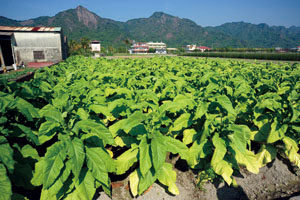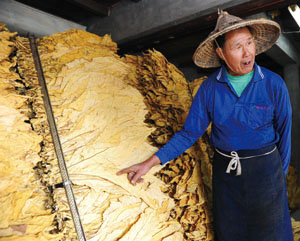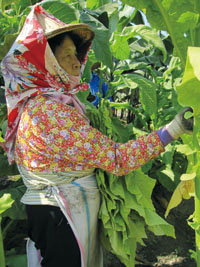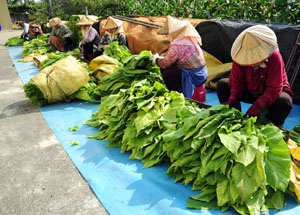Meinong's Tobacco Industry / 美濃菸業
Meinong's Tobacco Industry
◎English written by Peng Hsin-yi
◎Photos by Pao Chung-hui, Yang Chan-hua, Hou Ya-ting
 Meinong's tobacco lifecycle begins in October. Tobacco takes three months to grow and is planted between the bi-annual rice crops. The field is first prepared, seeds are sown and plants are tended, harvested, baked, conditioned and finally sold to the government.
Meinong's tobacco lifecycle begins in October. Tobacco takes three months to grow and is planted between the bi-annual rice crops. The field is first prepared, seeds are sown and plants are tended, harvested, baked, conditioned and finally sold to the government.
During the harvest in January, farmers work in a co-op. Now aged 50-80, they move systematically with precision through the fields, severing tobacco leaves with a rhythmic "clip clip". Each day the harvest begins around 11:30 a.m. This is because the crops are drier from the dew, making the baking process easier. Tobacco leaves are stashed in canvas slings, tied into bundles of 20 kilos (approximately 40 lbs) and then sent to baking.
The tobacco leaves are then transported to the warehouse sized baking chamber. The farmers secure the leaves to baking racks and hang them up in neat rows. The baking process takes about 10 days. The baking chamber temperature and air flow controls are now computerized, but the whole process still requires masterful experience. The fragrance of ripe tobacco leaves is an aroma that is enjoyed by everyone. While the leaves bake, farmers are back in the fields, getting ready for the second rice season. When the tobacco baking process is complete, farmers begin the conditioning process. The leaves are sorted into different grades and then sold to the Taiwan Tobacco and Liquor Corporation (TTLC).
Meinong's tobacco industry began in 1938 and reached its peak in the 50s and 60s. During those golden days, Meinong boasted more than 2500 hectares of tobacco fields and produced one quarter of Taiwan's tobacco. Today, Meinong sustains only 180 hectares of tobacco. The decline began in the 1970s, with the General Agreement on Tariffs and Trade (GATT) lifting the tariff barrier on foreign tobacco. The Taiwan Tobacco and Wine Monopoly Bureau (the former name of the TTLC) began to suffer financially, and in 2000 the government began a campaign encouraging farmers to discontinue tobacco farming.
In 2002, the Taiwan Tobacco and Wine Monopoly Bureau became Taiwan Tobacco and Liquor Corporation (TTLC) and changes were made to the tobacco procurement structure. In the past farmers would make hefty earnings, as the government purchased it at a guaranteed price. However, the government has now discontinued the guaranteed price for tobacco leaves and contracts tobacco farmers based on projected demand. In the past, children of tobacco farmers were financed through high levels of education, earning Meinong the nickname "a village of PhDs".
 One farmer known as Uncle Ah-Li has been growing tobacco for more than half a century. He fears a trade that took him a life time to master, may come to an end in a generation or two. However, the people of Meinong state they will stay loyal to the trade that helped them raise their children. Tobacco farming has also shaped a unique co-op culture. During the harvest, every household is mobilized.
One farmer known as Uncle Ah-Li has been growing tobacco for more than half a century. He fears a trade that took him a life time to master, may come to an end in a generation or two. However, the people of Meinong state they will stay loyal to the trade that helped them raise their children. Tobacco farming has also shaped a unique co-op culture. During the harvest, every household is mobilized.
Friends and family work together in each other's fields, solidifying friendships that go back generations.
The village's collective opinions even influence local elections. The tobacco co-op not only provides financial means but also serves as a vehicle in forming a collective social awareness. Although Tobacco farming in Meinong may soon come to an end, the sight of a room full of golden leaves and an aroma of expertly baked tobacco will forever stay in the minds and hearts of the people.
美濃菸業
◎文/侯雅婷 ◎攝影/鮑忠暉、楊蟬華、侯雅婷
 暖暖冬陽的一月,一群年紀約莫50 ~80歲的農戶們騎乘機車穿梭在美濃阡陌間,這是美濃菸農每到菸葉採收期展開「交工」模式(互助)的景象,菸農們彼此互相支援,每到一個菸田,合作無間的菸農們迅速地折著菸葉,田裏發出「啪啪」的聲響此起彼落,像極了田裡的交響樂聲。菸農會將摘好的菸葉放在帆布裏,到達約20公斤的數量,就會捆成一大綑,成綑新鮮的菸葉在卡車上堆疊好後,被送到菸農家進行為期十天的「烤菸」。這段期間菸農們仍舊穿梭在完全沒有路標、彎彎曲曲的田間小路,從一個菸田移動到另一個菸田,繼續採菸葉的工作。菸農會在中午11點半準時到工作地點,經驗老到的採菸葉阿姨說,早晨的菸葉因為有露水會增加烤菸的時間,所以不適合摘菸葉,中午的菸葉葉片較軟且不會濕濕的,所以選在中午時段開始摘菸葉。
暖暖冬陽的一月,一群年紀約莫50 ~80歲的農戶們騎乘機車穿梭在美濃阡陌間,這是美濃菸農每到菸葉採收期展開「交工」模式(互助)的景象,菸農們彼此互相支援,每到一個菸田,合作無間的菸農們迅速地折著菸葉,田裏發出「啪啪」的聲響此起彼落,像極了田裡的交響樂聲。菸農會將摘好的菸葉放在帆布裏,到達約20公斤的數量,就會捆成一大綑,成綑新鮮的菸葉在卡車上堆疊好後,被送到菸農家進行為期十天的「烤菸」。這段期間菸農們仍舊穿梭在完全沒有路標、彎彎曲曲的田間小路,從一個菸田移動到另一個菸田,繼續採菸葉的工作。菸農會在中午11點半準時到工作地點,經驗老到的採菸葉阿姨說,早晨的菸葉因為有露水會增加烤菸的時間,所以不適合摘菸葉,中午的菸葉葉片較軟且不會濕濕的,所以選在中午時段開始摘菸葉。
十月時,美濃菸葉開始播種,菸葉是一年兩收稻作之間的裡作,菸葉種植期為3個月,菸作過程包括整地、領種、種植、採收、燻烤、調理、送繳(繳賣) 等過程。過去因為政府價格保證制度下 ,相對於其他農作物而言,菸葉保有相當的利潤,菸葉帶動經濟發展,讓菸農子弟能接受教育,很多美濃子弟都取得博士學位,美濃也因此贏得「博士村」的美名。
菸農們採收完菸葉,會再集合協助將菸葉夾在菸架上,排列整齊的掛在倉庫大般的燻烤室,須連續燻烤10天,雖然燻烤菸葉已採用電腦烘乾機,但如何能烤出金黃色的菸葉,火候的調整仍仰賴老師傅本身的經驗。烤出堆滿整個倉庫的菸葉,視覺上呈現迷人的金黃色,味覺上更散發出難以想像的菸草香。
等待燻烤期間菸農們同時得進行插秧的稻作工作,,燻烤後的菸葉須經過「 調理」,即依燻烤後的菸草等級分類,以便繳交給菸酒公司收購,此時栽種菸葉的辛勤才算暫告一個段落。
 美濃區現栽種180公頃的菸田,1938 年美濃進入種植菸草的時代,在菸業全盛時期的50~60年代,美濃栽種菸葉面積達2500多公頃,約佔全台四分之一的菸葉種植面積,在台灣加入關貿總協(GATT)後,美濃菸業種植面積於70年代逐年遞減。菸酒公賣局在外國菸葉,香菸自由進口的夾擊下,不敷成本,民國90年底至91年間,政府開始鼓勵菸農申請廢耕,並提出以補償金收回專賣時期「許可證」的菸葉種植面積,取消「保證價格」制度收購菸葉,2002年菸酒公賣局正式改制為菸酒公司,也逐年減少收購菸葉,既有的菸草收購模式大幅調整 ,將原先由公賣局許可的「專賣契作」模式,改為菸酒公司與菸農組織團體就菸草需求量進行簽約契作,不再享有專賣時期的「許可制」和「保證價格」 ,美濃菸業成為黃昏產業。種植菸業逾50年的阿力伯說,菸農們有燻烤菸葉的設備,更有技術和經驗,儘管年紀也大了 ,種植菸葉並不輕鬆,還是希望能繼續從事種植菸葉的工作。
美濃區現栽種180公頃的菸田,1938 年美濃進入種植菸草的時代,在菸業全盛時期的50~60年代,美濃栽種菸葉面積達2500多公頃,約佔全台四分之一的菸葉種植面積,在台灣加入關貿總協(GATT)後,美濃菸業種植面積於70年代逐年遞減。菸酒公賣局在外國菸葉,香菸自由進口的夾擊下,不敷成本,民國90年底至91年間,政府開始鼓勵菸農申請廢耕,並提出以補償金收回專賣時期「許可證」的菸葉種植面積,取消「保證價格」制度收購菸葉,2002年菸酒公賣局正式改制為菸酒公司,也逐年減少收購菸葉,既有的菸草收購模式大幅調整 ,將原先由公賣局許可的「專賣契作」模式,改為菸酒公司與菸農組織團體就菸草需求量進行簽約契作,不再享有專賣時期的「許可制」和「保證價格」 ,美濃菸業成為黃昏產業。種植菸業逾50年的阿力伯說,菸農們有燻烤菸葉的設備,更有技術和經驗,儘管年紀也大了 ,種植菸葉並不輕鬆,還是希望能繼續從事種植菸葉的工作。
菸業繁榮了美濃,也衍生農村勞動合作模式的「交工」文化,更對美濃造成深遠的影響,「交工」指每到菸葉採收季節,農戶全家總動員,協調親朋好友左鄰右舍幫忙採收,甚至菸農世代彼此往來,建立深厚交情,從獨特的耕作文化發展到社會組織,交工戶數越多,其影響力越大,每逢選舉時,往往能左右地方選舉,菸業的發展凝聚起菸農的地方向心力。
對美濃的菸農而言,滿室燻烤後金黃色的菸葉,結合菸草燻烤後的菸草香氣 ,這金黃色視覺結合菸草嗅覺的印象與感動,深深烙印在美濃人的記憶中。儘管菸業的風華不在,務實的美濃人仍緊守著這養大孩子的產業。